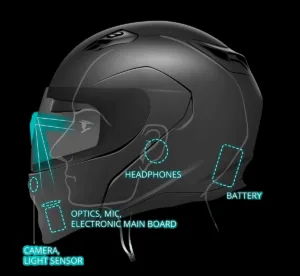The augmented reality motorcycle helmet developed by LiveMap (Moscow, Russian Federation) has now evolved into a working prototype.

LiveMap reported that the company has succeeded in producing the so-called Prototype C and that it embodies improvements over previously shown versions. Improvements include optics that are both better and smaller and a PCB that is now without cords making the helmet self-contained.
The underlying idea behind the LiveMap helmet is the belief that an augmented reality interface is a superior way to present information to a motorcycle rider. The reason is that an AR system projects a transparent, color image at a distance out in front of the rider. Presumably (and reasonably) this enhances safety by allowing the rider to get information while still staying fully focused on the road. When saying that the approach is superior, comparison is being made to the conventional approach of providing information to a rider through the use of display screens that require the rider to look down, taking their eyes off the road.
The helmet shell is made of carbon fiber. It is represented as “flexible since it offers an open-faced helmet while giving you protection of a closed faced helmet when you flip the front section downwards.”
An illustration of the component layout in the helmet appears in the figure below. A small projector is mounted in the chin of the helmet. Utilizing Android based software, the projector projects imagery onto a small transparent screen attached to the visor. The company states that, in the final version of the helmet, the image will be projected directly onto the visor.
A schematic of the LiveMap motorcycle helmet.
The company explained that it is typical for an automobile style heads-up display to project a virtual image at a distance of about 2.4 meters in front of the vehicle. The LiveMap helmet, on the other hand, projects the virtual image at a distance of about 20 meters in front of the rider. The additional distance is represented as more appropriate for a motorcyclist and, therefore, safer.
Some of the hardware in the helmet and some of the features of the helmet include the following:
- A light sensor automatically adjusts the image brightness according to external light conditions
- Built in 4k front camera
- Charge with a single device either at home or en route.
- Helmet weighs about 1.4 kg
- 4G LTE Advanced, Wi-Fi, Bluetooth
- GPS
- Two 3000 mAh batteries
- Two earphones
- G-sensor
- Gyroscope
- Digital compass for tracking head movement (the image changes with view direction)
The LiveMap helmet can be controlled with voice commands. Utilizing the system is similar to interacting with Siri or Google Now. The company claims 96% correct voice recognition.
Examples of the information presentation capabilities of the helmet include the following:
- Maps are pre-loaded, no need to download maps on the go.
- GPS route
- Route notifications which can be customized
- Speed and other parameters
- Alerts which can be customized
- Listen to music. The LiveMap helmet can connect to the user’s smartphone playlist
- Telephone related functions
All of the functions listed above are integrated into the AR helmet rather than residing in one or more separate devices. Based on this, the company suggests that the user is unlikely to lose a capability by forgetting a device.
A video at the end of this article discusses and illustrates the LiveMap motorcycle helmet.
It is interesting to note that, about four years ago, LiveMap conducted an IndieGoGo fundraising campaign. It was unsuccessful in that only 6% of the target $150,000 was pledged. At the conclusion of the unsuccessful campaign, the company stated that products would still be delivered because the company had been successful in finding investors. The existence of the Prototype C in 2018 seems to verify this as correct.
Andrew Artishchev, the founder of LiveMap, has stated that the company will get the LiveMap helmet certified and on the market. The certifications to which he refers includes USA DOT, European ECE 22.05 and Japanese JIS T 8133.
Pre-orders are now being accepted on the company web site. The pre-order price is $1500. The delivery date simply an estimate stated as “in 2018.” The regular retail price will be $2000. It can be noted that the voice recognition capability will initially be in English and that this is consistent with the fact that initial sales of the LiveMap helmet are planned for the U.S. -Arthur Berman

